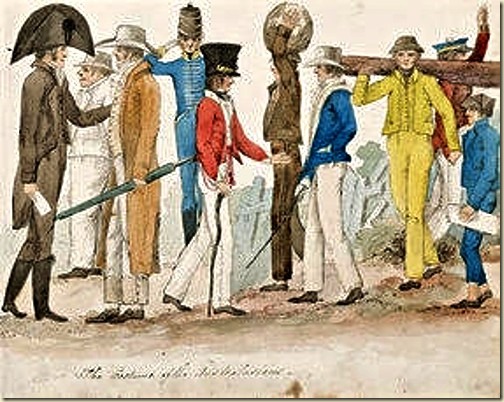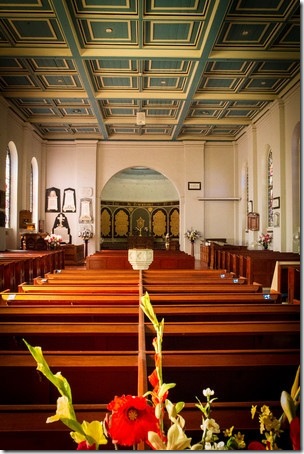Recent family history research has William Whitfield aged 10 on arrival in the colony, as indeed he is in the “Thames” passenger list. Also, it appears Jacob Whitfield’s first wife, Mary, was Goss not Gowrie.
Posted originally on 6 January, 2015 by Neil.
This series of posts is the most comprehensive I have done on family history. I am doing them backwards here so that in due course they will appear sequentially. Now it is finished, and you can just keep scrolling down to get a continuous set of posts!
I have decided to start a series going back through my “personal” decades – that is mentioning things from family history – starting with 1815, when most of my family connections were elsewhere. One exception — my former sister-in-law’s family: see Family stories 4 — A Guringai Family Story — Warren Whitfield. My former sister-in-law is a descendant of the family of Bungaree.
Sydney was a tad different c.1815:

1815
Jane Brooks writes of how Koorie people live in the Domain ‘in their gunyahs made of bushes.’ She also remembers seeing ‘the very tiny canoes with a gin (Koorie woman) fishing in them, quite alone, sometimes with a streak of smoke from it, and we supposed she was cooking.’ (Karskens, p. 209)
See also Bungaree and the George’s Head Settlement: 31 January 1815
On Tuesday last, at an early hour, HIS EXCELLENCY the GOVERNOR and Mrs. MACQUARIE, accompanied by a large party of Ladies and Gentlemen, proceeded in boats down the Harbour to George’s Head. The object of this excursion, we understand, was to form an establishment for a certain number of Natives who had shewn a desire to settle on some favourable spot of land, with a view to proceed to the cultivation of it; — The ground assigned them for this purpose (the peninsular of George’s Head) appears to have been judiciously chosen, as well from the fertility of the soil as from its requiring little exertions of labour to clear and cultivate; added to which, it possesses a peculiar advantage of situation; from being nearly surrounded on all sides by the sea; thereby affording its new possessors the constant opportunity of pursuing their favorite occupation of fishing, which has always furnished the principal source of their subsistence.
On this occasion, sixteen of the Natives, with their wives and families were assembled, and HIS EXCELLENCY the GOVERNOR, in consideration of the general wish previously expressed by them, appointed Boongaree (who has been long known as one of the most friendly of this race, and well acquainted with our language), to be their Chief, at the same time presenting him with a badge distinguishing his quality as “Chief of the Broken Bay Tribe,” and the more effectually to promote the objects of this establishment, each of them was furnished with a full suit of slop clothing, together with a variety of useful articles and implements of husbandry, by which they would be enabled to proceed in the necessary pursuits of agriculture; — A boat (called the Boongaree was likewise presented them for the purpose of fishing.
About noon, after the foregoing ceremony had been concluded, HIS EXCELLENCY and party returned to Sydney, having left the Natives with their Chief in possession of their newly assigned settlement, evidently much pleased with it, and the kindness they experienced on the occasion.
We Whitfields were presumably in this part of the world in 1815:

Before the next decade the first one of them would arrive in Sydney involuntarily. I note a new family history source, by the way, on Wikitree, maintained by a distant relative, Sandra Green, which reminds us that my great-great-grandfather William Whitfield was born 16 Mar 1812 , Parish of Drumgoon, Cootehill, Co. Cavan, Ireland, arrived on the “Thames” from Cork via Brazil and Cape Horn, age 14, married Caroline Philadelphia West 1836, died Sydney 1897. The Wikitree page includes copies of the inquest finding into his death and his death certificate, and this portrait with his wife Caroline:

On my mother’s side of my family – the Christisons – I note my great-great-great-grandfather David was a teenager in 1815, having been born in 1799 in Fettercairn, Kincardine. Seems the poor old sod died in the poorhouse July 21, 1860 of chronic bronchitis. His wife had also died July 2, 1859 in Poorhouse, Luthermuir, Marykirk, Kincardine. That I’d never known before. Note Poorhouses in Scotland “provided medical and nursing care of the elderly and the sick, at a time when there were few hospitals and private medical treatment was beyond the means of the poor.”
David’s son, also David (b May 1828), ended up in Australia when his son, John Hampton Christison, brought him here from Brechin in Scotland. Or did he? Is this Brechin David the same as Fettercairn David? The family pictured below are definitely my ancestors and in the later 19th century for sure they were in Brechin. That is surely J H Christison’s parents and siblings.

David Hampton Christison, father of of my grandfather John, in Scotland. Exactly when and where was he born?
The photo is from Arbroath near Brechin.
Fettercairn David Senior married a Hampton or Hanton; this suggests that they are my maternal family: the Hampton name persists to this day. The date on David Junior’s gravestone is one year out though. So I am left wondering if we have two families here… Mind you, Fettercairn and Brechin are not all that far apart. That poorhouse is halfway between. Perhaps the family just moved a bit south.
The Niven Family Tree claims David Hampton Christison was born July 13 1829 in Fife,Ceres Scotland. That makes even less sense of the gravestone! And Fife doesn’t seem right, given the photo above.

See also Fascinated still by (family) history (November 2013) and My great-grandfather: “morally dubious to say the least.” (October 2013).
Meantime in the big world in July 1815:

Sir William Quiller Orchardson — “Napoleon on Board the Bellerophon”


















